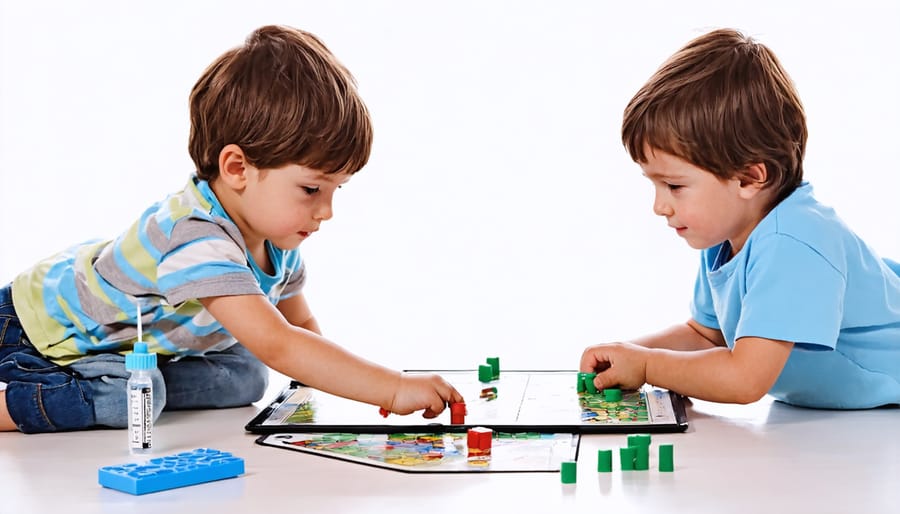Family dynamics shape every aspect of our emotional and psychological well-being, influencing how we connect, communicate, and help children thrive within the complex web of relationships that define our home life. Like a delicate ecosystem, each family member’s actions, emotions, and needs create ripple effects that touch everyone in the household. Understanding these intricate patterns isn’t just academic—it’s essential for building stronger relationships, fostering emotional resilience, and creating a nurturing environment where every family member can flourish.
When chronic illness enters this equation, it fundamentally shifts the family’s emotional landscape. Parents often find themselves balancing the needs of their ill child with those of their other children, while simultaneously managing their own concerns and anxieties. This delicate balancing act requires not just practical solutions, but a deep understanding of how illness affects family relationships at their core.
Yet within these challenges lie opportunities for growth, connection, and profound healing. By recognizing and acknowledging how illness impacts each family member differently, we can develop strategies that strengthen bonds, improve communication, and create a support system that benefits everyone involved. Whether you’re a parent, caregiver, or healthcare professional, understanding family dynamics is the first step toward building a more resilient, supportive, and emotionally healthy family unit.

How Families Change When Illness Arrives
New Family Roles and Responsibilities
When families face significant changes or challenges, members often naturally shift into new roles to maintain balance and support one another. Children might take on more responsibilities, while parents may need to adjust their traditional roles to accommodate new circumstances. For example, a teenager might help more with household chores or assist younger siblings with homework when a parent is working longer hours.
These role adaptations can be both positive and challenging. While they can foster independence and empathy, it’s important to ensure that new responsibilities are age-appropriate and don’t overwhelm family members, especially children. Parents should openly communicate about these changes and acknowledge everyone’s contributions to the family unit.
Family therapists often observe that successful adaptation occurs when changes are discussed openly and roles are negotiated rather than imposed. As Dr. Sarah Chen, a family counselor, notes, “Healthy role transitions happen when families maintain open dialogue and ensure everyone feels heard and supported in their new responsibilities.”
Remember that role changes are often temporary, and flexibility is key. Regular family meetings can help ensure that responsibilities remain balanced and that no one feels overwhelmed by their new role.
Changes in Daily Routines
When a family member faces medical challenges, daily routines often need careful adjustment to ensure everyone’s needs are met. Simple activities like morning preparations, mealtimes, and bedtime rituals may require new approaches. For instance, medication schedules might need to be synchronized with school or work times, and doctor appointments may reshape the family calendar.
These changes can feel overwhelming at first, but they often bring unexpected opportunities for family bonding. Many families find success in creating visual schedules or using shared digital calendars to keep track of medical responsibilities alongside regular activities. This helps everyone stay informed and involved.
It’s important to maintain some familiar routines while adapting others. Children especially benefit from predictability, even when dealing with health challenges. Consider designating specific times for family activities that aren’t focused on medical care, such as reading together or sharing meals.
Remember that flexibility is key – some days will flow smoothly, while others might require last-minute adjustments. The goal isn’t perfection but rather creating a sustainable rhythm that works for everyone while ensuring necessary medical care remains a priority.
Through a Child’s Eyes
Understanding Siblings’ Feelings
When a family member faces ongoing health challenges, healthy siblings often experience a complex mix of emotions that parents might not immediately recognize. These children may feel guilt for being healthy, anxiety about their sibling’s condition, or even resentment about the extra attention their sibling receives.
Dr. Sarah Martinez, a family therapist, shares, “Many siblings struggle with feeling invisible while simultaneously dealing with increased responsibilities at home. It’s a delicate balance that needs acknowledgment and support.”
Healthy siblings might experience:
– Worry about their sibling’s well-being
– Jealousy over divided parental attention
– Pressure to be “perfect” or not cause additional stress
– Confusion about their role in the family
– Loneliness or isolation from peers who may not understand their situation
Parents often notice behavioral changes in healthy siblings, such as:
– Becoming overly helpful or responsible
– Acting out to gain attention
– Withdrawing from family activities
– Declining academic performance
– Experiencing physical symptoms like headaches or stomach aches
It’s essential to create safe spaces for healthy siblings to express their feelings without judgment. Regular one-on-one time with parents, maintaining normal routines, and connecting with other children in similar situations can help them process their emotions healthily. Remember, acknowledging and validating their feelings is crucial for their emotional well-being and the overall family dynamic.

The Ill Child’s Perspective
Children living with chronic illness often experience a complex mix of emotions that can be challenging for both them and their families to navigate. Many feel a deep sense of guilt, worried they’re burdening their parents and siblings with their medical needs and care requirements. This guilt frequently intensifies when they see how their condition affects family plans, finances, or their siblings’ activities.
Frustration is another common emotion, particularly when their illness prevents them from participating in activities they enjoy. Maintaining social connections becomes increasingly important yet challenging, as medical appointments and treatments often interrupt school attendance and social gatherings.
The overwhelming desire for normalcy is perhaps one of the most powerful feelings these children experience. They may resist taking medications, following treatment plans, or acknowledging their limitations simply because they want to feel like everyone else. This yearning for ordinary experiences can manifest in different ways – some children might push themselves too hard, while others might withdraw from activities altogether.
Many ill children also struggle with feeling different or misunderstood by their peers. They may experience anxiety about their condition, fear about the future, or sadness about missing out on typical childhood experiences. Understanding these emotional challenges is crucial for parents and caregivers to provide appropriate support and create an environment where children feel heard and validated.
Supporting Your Child’s Emotional Well-being
Open Communication Strategies
Maintaining open communication within families requires intentional effort and consistent practice. One effective approach is establishing regular family meetings where everyone gets a chance to speak without judgment. These gatherings can be informal, like during dinner time or weekend breakfasts, creating a safe space for sharing thoughts and feelings.
Active listening plays a crucial role in family dialogue. When family members speak, give them your full attention, maintain eye eye contact, and validate their emotions. Simple phrases like “I understand how you feel” or “Thank you for sharing that with me” can encourage more open dialogue.
Creating a “feelings-friendly” environment helps children express themselves more freely. Use “I” statements instead of accusatory language, such as “I feel worried when…” rather than “You always make me…” This approach reduces defensiveness and promotes understanding.
Consider implementing a daily check-in routine with each family member. Even five minutes of one-on-one time can make a significant difference in maintaining connection. During these moments, ask open-ended questions that invite conversation rather than yes/no responses.
When conflicts arise, focus on problem-solving rather than blame. Encourage family members to suggest solutions and work together to find compromises. Remember that healthy communication also includes respecting boundaries and acknowledging when someone needs space to process their emotions.
Creating Safe Spaces for Expression
Creating a safe space for children to express their feelings is crucial for healthy emotional development. When children feel secure sharing their thoughts and concerns, they’re more likely to develop emotional resilience and maintain open communication with family members.
Start by establishing regular “feelings check-ins” – dedicated times when family members can share their emotions without fear of judgment. This could be during dinner, before bedtime, or during weekend family meetings. Use gentle prompts like “How did that make you feel?” or “Would you like to talk about it?” rather than pushing for immediate responses.
Create physical spaces in your home that promote comfort and security. This might be a cozy corner with soft pillows, a special chair, or even a tent where children can retreat when they need quiet time. Keep art supplies, journals, or emotion cards nearby to help children express feelings through different mediums.
Practice active listening by maintaining eye contact, putting away phones, and reflecting back what your child says. Validate their emotions with responses like “That must have been really frustrating” or “It’s okay to feel sad about this.” Remember that some children may prefer expressing themselves through play, drawing, or writing rather than direct conversation.
Set an example by sharing your own feelings appropriately and showing how to handle difficult emotions constructively. This helps normalize emotional expression and teaches healthy coping strategies.
Building Family Resilience

Family Activities and Connection
Maintaining strong family connections requires intentional effort, but the rewards are immeasurable. Simple activities can help strengthen bonds and create lasting memories, even during challenging times. Consider establishing weekly family game nights where everyone unplugs from devices and enjoys quality time together. Board games, card games, or even charades can spark laughter and conversation.
Create family traditions that everyone looks forward to, such as Sunday morning pancake breakfasts or monthly movie nights with homemade popcorn. These consistent activities provide stability and something positive to anticipate, especially during stressful periods.
Outdoor activities like nature walks, bike rides, or backyard picnics offer opportunities for natural conversation and physical activity. Even daily routines can become meaningful connection points – cooking dinner together, helping with homework, or sharing “highs and lows” at bedtime.
Remember that connection doesn’t always require elaborate plans. Sometimes the most meaningful moments happen during casual car rides or while folding laundry together. Create a “family gratitude jar” where everyone adds notes about things they appreciate about each other. Read these together during special occasions to reinforce positive family bonds.
For families facing particular challenges, consider starting a shared journal where family members can express feelings and support each other. This provides a safe space for open communication and helps maintain emotional connections even when face-to-face time is limited.
Finding Support Systems
Building strong support networks outside your immediate family can make a significant difference in managing complex family dynamics. Start by connecting with other parents who share similar experiences through local support groups or online communities. These connections can provide valuable emotional support, practical advice, and a safe space to share your concerns.
Consider reaching out to school counselors, family therapists, or mental health professionals who specialize in family relationships. They can offer professional guidance tailored to your family’s unique situation and help develop effective communication strategies.
Extended family members, trusted friends, and community leaders can also become valuable allies in your support system. They can provide respite care, emotional backing, and different perspectives on challenging situations. Religious or spiritual communities, if aligned with your beliefs, often offer additional layers of support and understanding.
Remember that building a support system takes time and effort. Start small by identifying one or two trusted individuals or organizations, then gradually expand your network as you feel comfortable. Online forums and social media groups can be excellent resources for connecting with others who understand your journey, especially during times when in-person support isn’t readily available.
Don’t hesitate to accept help when it’s offered – having a strong support system isn’t a sign of weakness but rather a testament to your commitment to your family’s well-being.
Family dynamics are ever-evolving, and while challenges are inevitable, the strength and resilience within families continue to amaze therapists and researchers alike. Throughout this journey of understanding and improving family relationships, remember that every small step forward matters. The strategies we’ve explored – from open communication to setting healthy boundaries and creating safe spaces for emotional expression – all contribute to building stronger family bonds.
What’s particularly encouraging is how families can adapt and grow stronger through difficulties. As Dr. Sarah Chen, a family therapist with over 20 years of experience, often says, “Families are like gardens – they need constant care, but with the right nurturing, they can flourish in any season.”
Remember to celebrate your family’s unique strengths while working on areas that need attention. Practice active listening, make time for both individual and shared activities, and maintain consistent family routines. These foundations create stability and security for all family members, especially during times of change or stress.
Most importantly, don’t hesitate to seek support when needed. Whether through family counseling, support groups, or educational resources, there are numerous ways to enhance your family’s emotional wellbeing. Every family faces its own set of challenges, but with patience, understanding, and the right tools, you can foster a nurturing environment where every member feels valued and understood.
As you continue this journey, stay hopeful and remember that building healthy family dynamics is an ongoing process. Your commitment to understanding and improving your family relationships is already a significant step toward creating the harmonious family life you envision.


